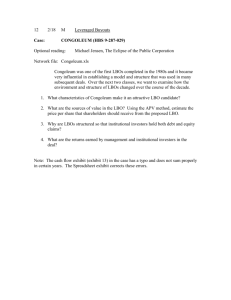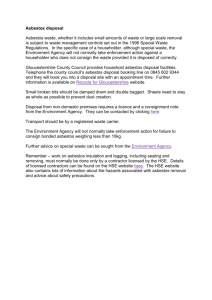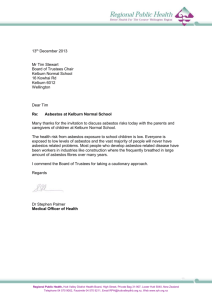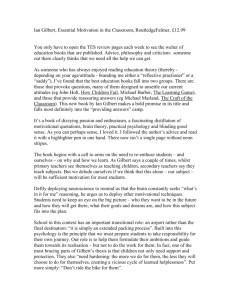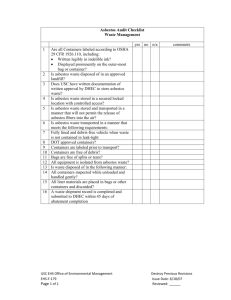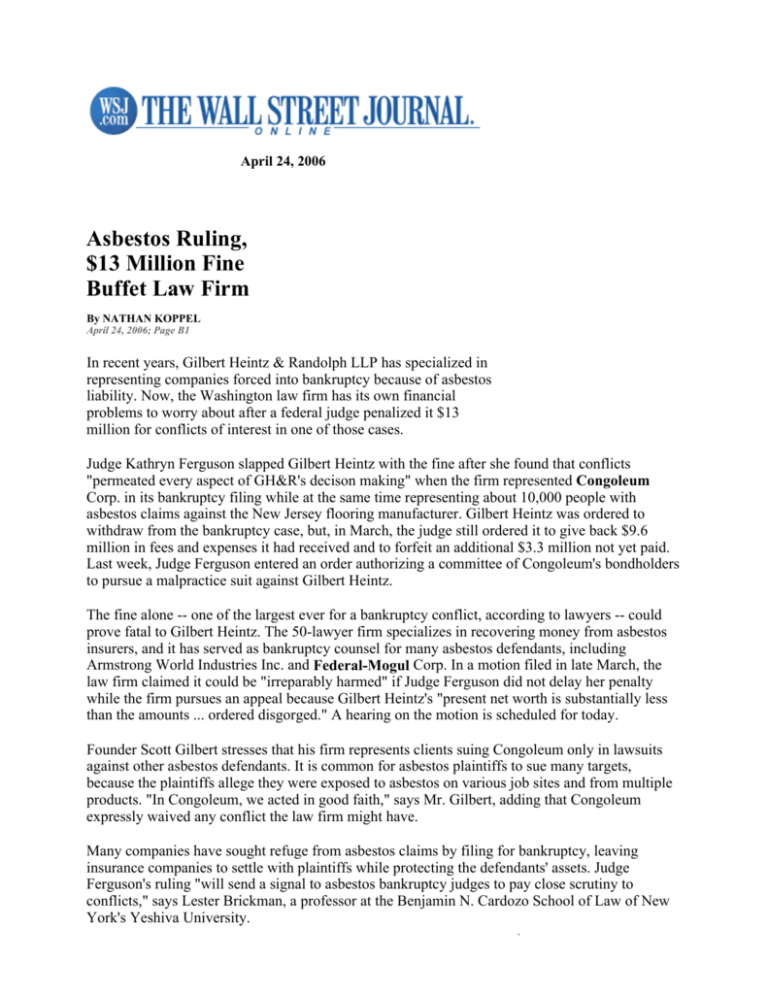
April 24, 2006
Asbestos Ruling,
$13 Million Fine
Buffet Law Firm
By NATHAN KOPPEL
April 24, 2006; Page B1
In recent years, Gilbert Heintz & Randolph LLP has specialized in
representing companies forced into bankruptcy because of asbestos
liability. Now, the Washington law firm has its own financial
problems to worry about after a federal judge penalized it $13
million for conflicts of interest in one of those cases.
Judge Kathryn Ferguson slapped Gilbert Heintz with the fine after she found that conflicts
"permeated every aspect of GH&R's decison making" when the firm represented Congoleum
Corp. in its bankruptcy filing while at the same time representing about 10,000 people with
asbestos claims against the New Jersey flooring manufacturer. Gilbert Heintz was ordered to
withdraw from the bankruptcy case, but, in March, the judge still ordered it to give back $9.6
million in fees and expenses it had received and to forfeit an additional $3.3 million not yet paid.
Last week, Judge Ferguson entered an order authorizing a committee of Congoleum's bondholders
to pursue a malpractice suit against Gilbert Heintz.
The fine alone -- one of the largest ever for a bankruptcy conflict, according to lawyers -- could
prove fatal to Gilbert Heintz. The 50-lawyer firm specializes in recovering money from asbestos
insurers, and it has served as bankruptcy counsel for many asbestos defendants, including
Armstrong World Industries Inc. and Federal-Mogul Corp. In a motion filed in late March, the
law firm claimed it could be "irreparably harmed" if Judge Ferguson did not delay her penalty
while the firm pursues an appeal because Gilbert Heintz's "present net worth is substantially less
than the amounts ... ordered disgorged." A hearing on the motion is scheduled for today.
Founder Scott Gilbert stresses that his firm represents clients suing Congoleum only in lawsuits
against other asbestos defendants. It is common for asbestos plaintiffs to sue many targets,
because the plaintiffs allege they were exposed to asbestos on various job sites and from multiple
products. "In Congoleum, we acted in good faith," says Mr. Gilbert, adding that Congoleum
expressly waived any conflict the law firm might have.
Many companies have sought refuge from asbestos claims by filing for bankruptcy, leaving
insurance companies to settle with plaintiffs while protecting the defendants' assets. Judge
Ferguson's ruling "will send a signal to asbestos bankruptcy judges to pay close scrutiny to
conflicts," says Lester Brickman, a professor at the Benjamin N. Cardozo School of Law of New
York's Yeshiva University.
.
The Senate is considering legislation that provides for asbestos claims to be paid out of a trust
fund underwritten by asbestos defendants and their insurers. But the legislation is in a holding
pattern, meaning bankruptcy courts will remain a prime battleground for resolving asbestos
claims, says Glenn Lammi, a lawyer with the pro-business Washington Legal Foundation. In
bankruptcies like Congoleum, he adds, "where a company's lawyers were supposedly on both
sides of the fence, courts need to worry whether asbestos claims negotiations are at arm's length."
Insurance companies raised conflict objections in the Congoleum case, only because Gilbert
Heintz has been so successful "recovering money from asbestos insurers," says plaintiffs lawyer
Steven Kazan, who has asbestos claims against Congoleum. "It's a Tonya Harding situation: If
you can't beat her on the ice, then kneecap her." But Prof. Brickman, who has followed the
Congoleum bankruptcy, says Gilbert Heintz's conflicts were a prime reason Congoleum agreed in
the bankruptcy not to contest "bogus asbestos claims."
Congoleum declined to comment. The company still faces thousands of claims, even though it has
not manufactured floor products containing asbestos since the early 1980s.
Under its reorganization plan, Congoleum offered to pay more than $465 million to settle asbestos
claims, according to court filings. In 2005, Congoleum's insurers objected to the proposed
settlement, claiming Gilbert Heintz's conflicts resulted in a "collusive" agreement potentially
allowing recovery to people who merely claim, without proof, that they were exposed to a
Congoleum product. "Claimants who do nothing more than assert that they ... once walked on or
in the vicinity of at least one Congoleum tile" can seek recovery, according to a brief filed by
Congoleum's insurers, including Travelers Casualty & Surety Co. and Continental Casualty Co.
"The negotiation process was at arm's length, and the settlement reached was reasonable," Mr.
Gilbert counters. Congoleum has yet to finalize a settlement or file a reorganization plan.
Mr. Gilbert is now focused on his own firm's debts. In the buttoned-up legal world, Gilbert Heintz
cuts a rakish figure. The firm has a Ducati and antique Harley-Davidson motorcycles in its lobby,
as well as rock 'n' roll artifacts on its walls, including a guitar signed by the Grateful Dead's Bob
Weir. But in a recent filing, a U.S. bankruptcy trustee in New Jersey focused on another
possession -- Gilbert Heintz's $2.5 million plane -- to argue that the firm is able to pay its conflict
fine immediately.
Judge Ferguson hasn't been a wellspring of sympathy, either. In an earlier court proceeding, she
responded tartly to Gilbert Heintz's argument that it's unfair to force it to give up all of its fees in
the case. Gilbert Heintz, the judge said, reminded her of the "story of the boy who murdered both
his parents and then asked the court to take pity on a poor orphan."
Write to Nathan Koppel at nathan.koppel@wsj.com1
URL for this article:
http://online.wsj.com/article/SB114583079091933552.html
Hyperlinks in this Article:
(1) mailto:nathan.koppel@wsj.com
Copyright 2006 Dow Jones & Company, Inc. All Rights Reserved

